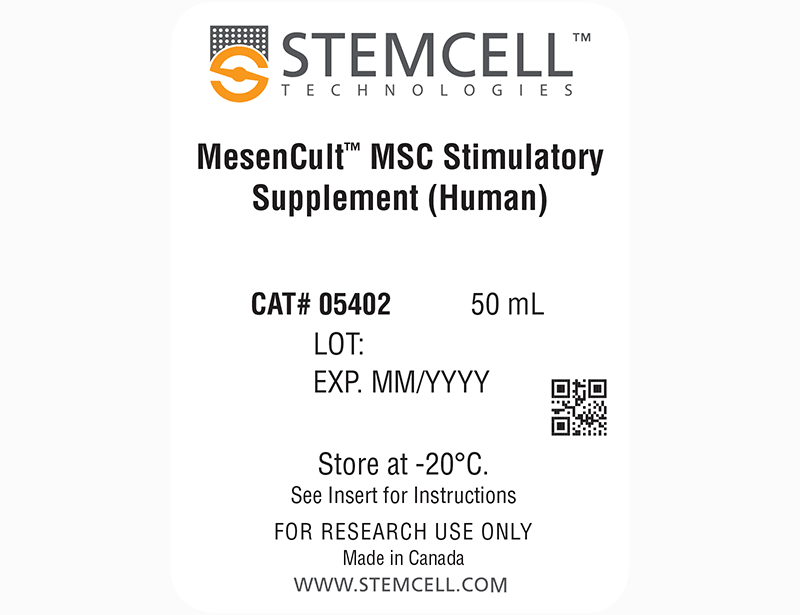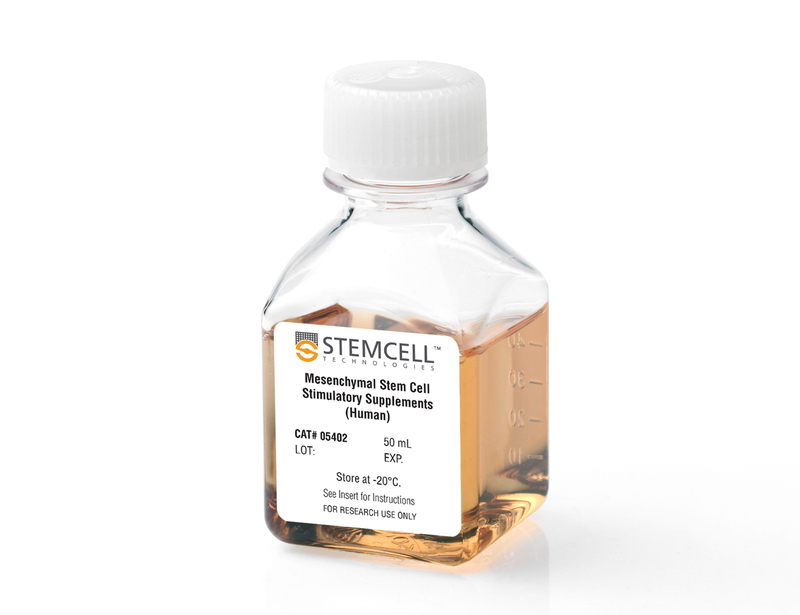MesenCult™ MSC Stimulatory Supplement (Human)
Supplement for detection of CFU-F and expansion of human mesenchymal stem cells
概要
MesenCult™ Mesenchymal Stem Cell Stimulatory Supplement (Human) is a standardized, serum-containing supplement for the culture of human mesenchymal stem cells (MSCs). MesenCult™ Mesenchymal Stem Cell Stimulatory Supplement (Human) is optimized for the expansion of human mesenchymal stem cells in vitro as well as their enumeration using the colony-forming unit - fibroblast (CFU-F) assay when combined with MesenCult™ MSC Basal Medium (Human). Components are pre-screened to minimize lot-to-lot variability. This supplement is also a component of MesenCult™ Proliferation Kit (Human; Catalog #05411).
Subtype
Supplements
Cell Type
Mesenchymal Stem and Progenitor Cells
Species
Human
Application
Cell Culture, Colony Assay, Expansion
Brand
MesenCult
Area of Interest
Stem Cell Biology
技术资料
| Document Type | 产品名称 | Catalog # | Lot # | 语言 |
|---|---|---|---|---|
| Product Information Sheet 1 | MesenCult™ MSC Stimulatory Supplement (Human) | 05402 | Lot 19D102073A or higher | English |
| Product Information Sheet 2 | MesenCult™ MSC Stimulatory Supplement (Human) | 05402 | 19A99097 or lower | English |
| Safety Data Sheet | MesenCult™ MSC Stimulatory Supplement (Human) | 05402 | All | English |
数据及文献
Publications (44)
International journal of molecular sciences 2020 mar
Tissue Engineered Esophageal Patch by Mesenchymal Stromal Cells: Optimization of Electrospun Patch Engineering.
Abstract
Abstract
Aim of work was to locate a simple, reproducible protocol for uniform seeding and optimal cellularization of biodegradable patch minimizing the risk of structural damages of patch and its contamination in long-term culture. Two seeding procedures are exploited, namely static seeding procedures on biodegradable and biocompatible patches incubated as free floating (floating conditions) or supported by CellCrownTM insert (fixed conditions) and engineered by porcine bone marrow MSCs (p-MSCs). Scaffold prototypes having specific structural features with regard to pore size, pore orientation, porosity, and pore distribution were produced using two different techniques, such as temperature-induced precipitation method and electrospinning technology. The investigation on different prototypes allowed achieving several implementations in terms of cell distribution uniformity, seeding efficiency, and cellularization timing. The cell seeding protocol in stating conditions demonstrated to be the most suitable method, as these conditions successfully improved the cellularization of polymeric patches. Furthermore, the investigation provided interesting information on patches' stability in physiological simulating experimental conditions. Considering the in vitro results, it can be stated that the in vitro protocol proposed for patches cellularization is suitable to achieve homogeneous and complete cellularizations of patch. Moreover, the protocol turned out to be simple, repeatable, and reproducible.
Journal of cellular physiology 2020 jan
Molecular mechanism underlying the difference in proliferation between placenta-derived and umbilical cord-derived mesenchymal stem cells.
Abstract
Abstract
The placenta and umbilical cord are pre-eminent candidate sources of mesenchymal stem cells (MSCs). However, placenta-derived MSCs (P-MSCs) showed greater proliferation capacity than umbilical cord-derived MSCs (UC-MSCs) in our study. We investigated the drivers of this proliferation difference and elucidated the mechanisms of proliferation regulation. Proteomic profiling and Gene Ontology (GO) functional enrichment were conducted to identify candidate proteins that may influence proliferation. Using lentiviral or small interfering RNA infection, we established overexpression and knockdown models and observed changes in cell proliferation to examine whether a relationship exists between the candidate proteins and proliferation capacity. Real-time quantitative polymerase chain reaction, western blot analysis, and immunofluorescence assays were conducted to elucidate the mechanisms underlying proliferation. Six candidate proteins were selected based on the results of proteomic profiling and GO functional enrichment. Through further validation, yes-associated protein 1 (YAP1) and $\beta$-catenin were confirmed to affect MSCs proliferation rates. YAP1 and $\beta$-catenin showed increased nuclear colocalization during cell expansion. YAP1 overexpression significantly enhanced proliferation capacity and upregulated the expression of both $\beta$-catenin and the transcriptional targets of Wnt signaling, CCND1, and c-MYC, whereas silencing $\beta$-catenin attenuated this influence. We found that YAP1 directly interacts with $\beta$-catenin in the nucleus to form a transcriptional YAP/$\beta$-catenin/TCF4 complex. Our study revealed that YAP1 and $\beta$-catenin caused the different proliferation capacities of P-MSCs and UC-MSCs. Mechanism analysis showed that YAP1 stabilized the nuclear $\beta$-catenin protein, and also triggered the Wnt/$\beta$-catenin pathway, promoting proliferation.
Nature immunology 2020
EBF1-deficient bone marrow stroma elicits persistent changes in HSC potential.
Abstract
Abstract
Crosstalk between mesenchymal stromal cells (MSCs) and hematopoietic stem cells (HSCs) is essential for hematopoietic homeostasis and lineage output. Here, we investigate how transcriptional changes in bone marrow (BM) MSCs result in long-lasting effects on HSCs. Single-cell analysis of Cxcl12-abundant reticular (CAR) cells and PDGFR$\alpha$+Sca1+ (P$\alpha$S) cells revealed an extensive cellular heterogeneity but uniform expression of the transcription factor gene Ebf1. Conditional deletion of Ebf1 in these MSCs altered their cellular composition, chromatin structure and gene expression profiles, including the reduced expression of adhesion-related genes. Functionally, the stromal-specific Ebf1 inactivation results in impaired adhesion of HSCs, leading to reduced quiescence and diminished myeloid output. Most notably, HSCs residing in the Ebf1-deficient niche underwent changes in their cellular composition and chromatin structure that persist in serial transplantations. Thus, genetic alterations in the BM niche lead to long-term functional changes of HSCs.
JCI insight 2019 aug
Mesenchymal stromal cells lower platelet activation and assist in platelet formation in vitro.
Abstract
Abstract
The complex process of platelet formation originates with the hematopoietic stem cell, which differentiates through the myeloid lineage, matures, and releases proplatelets into the BM sinusoids. How formed platelets maintain a low basal activation state in the circulation remains unknown. We identify Lepr+ stromal cells lining the BM sinusoids as important contributors to sustaining low platelet activation. Ablation of murine Lepr+ cells led to a decreased number of platelets in the circulation with an increased activation state. We developed a potentially novel culture system for supporting platelet formation in vitro using a unique population of CD51+PDGFRalpha+ perivascular cells, derived from human umbilical cord tissue, which display numerous mesenchymal stem cell (MSC) properties. Megakaryocytes cocultured with MSCs had altered LAT and Rap1b gene expression, yielding platelets that are functional with low basal activation levels, a critical consideration for developing a transfusion product. Identification of a regulatory cell that maintains low baseline platelet activation during thrombopoiesis opens up new avenues for improving blood product production ex vivo.
Frontiers in immunology 2019
Defining the Signature of VISTA on Myeloid Cell Chemokine Responsiveness.
Abstract
Abstract
The role of negative checkpoint regulators (NCRs) in human health and disease cannot be overstated. V-domain Ig-containing Suppressor of T-cell Activation (VISTA) is an Ig superfamily protein predominantly expressed within the hematopoietic compartment and has been studied for its role in the negative regulation of T cell responses. The findings presented in this study show that, unlike all other NCRs, VISTA deficiency dramatically impacts on macrophage cytokine and chemokine production, as well as the chemotactic response of VISTA-deficient macrophages. A select group of inflammatory chemokines, including CCL2, CCL3, CCL4, and CCL5, was strikingly elevated in culture supernatants from VISTA KO macrophages. VISTA deficiency also altered chemokine receptor recycling and profoundly disrupted myeloid chemotaxis. The impact of VISTA deficiency on chemotaxis in vivo was apparent with the reduced ability of both KO macrophages and MDSCs to migrate to the tumor microenvironment. This is the first demonstration of an NCR impacting on myeloid mediator production and chemotaxis, and will guide the use of anti-VISTA therapeutics to manipulate the chemotaxis of inflammatory macrophages or immunosuppressive MDSCs in inflammatory diseases and cancer.
PloS one 2019
Isolation of adipose tissue derived regenerative cells from human subcutaneous tissue with or without the use of an enzymatic reagent.
Abstract
Abstract
Freshly isolated, uncultured, autologous adipose derived regenerative cells (ADRCs) have emerged as a promising tool for regenerative cell therapy. The Transpose RT system (InGeneron, Inc., Houston, TX, USA) is a system for isolating ADRCs from adipose tissue, commercially available in Europe as a CE-marked medical device and under clinical evaluation in the United States. This system makes use of the proprietary, enzymatic Matrase Reagent for isolating cells. The present study addressed the question whether the use of Matrase Reagent influences cell yield, cell viability, live cell yield, biological characteristics, physiological functions or structural properties of the ADRCs in final cell suspension. Identical samples of subcutaneous adipose tissue from 12 subjects undergoing elective lipoplasty were processed either with or without the use of Matrase Reagent. Then, characteristics of the ADRCs in the respective final cell suspensions were evaluated. Compared to non-enzymatic isolation, enzymatic isolation resulted in approximately twelve times higher mean cell yield (i.e., numbers of viable cells/ml lipoaspirate) and approximately 16 times more colony forming units. Despite these differences, cells isolated from lipoaspirate both with and without the use of Matrase Reagent were independently able to differentiate into cells of all three germ layers. This indicates that biological characteristics, physiological functions or structural properties relevant for the intended use were not altered or induced using Matrase Reagent. A comprehensive literature review demonstrated that isolation of ADRCs from lipoaspirate using the Transpose RT system and the Matrase Reagent results in the highest viable cell yield among published data regarding isolation of ADRCs from lipoaspirate.


